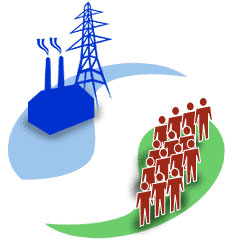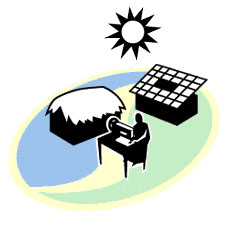|
The Greenstar Challenge
-
and Opportunity
 Is the dysfunctional
view of our energy and environmental options, widely advertised
by some, the only choice? Is the dysfunctional
view of our energy and environmental options, widely advertised
by some, the only choice?
An alternative way to look at the energy situation is that it
is a huge, and vastly profitable, business opportunity. Consider
that 40% of the world's population, 2 billion humans living in
over 600,000 villages, have no electricity. This suggests that
we are currently only producing about 60% of the electricity
the world requires. The market needs to grow tremendously; there
is an enormous opportunity for the bold.
Far from decreasing our energy production, we must increase it
dramatically if we are to meet our moral obligations with respect
to the Less Developed Countries. Yes, we should use our energy
more efficiently and with better understanding and wisdom, but
no amount of conservation will ever deliver electricity where
there is none.
Growth, New Markets
This growth in kilowatt-hours must occur without
further degrading the environment. Also, it is reasonably clear
that the 40% of the population which is currently not served
will never be served by very large, centralized, electrical generating
plants and mass distribution systems.
There is not enough capital, nor enough copper, to build out
our 20th century power system to create universal access to electricity.
This is quite similar to our historical experience with computers.
There is no way we could have delivered a mainframe computer
to everyone who would have benefited from using one.
We need new technologies if we want to solve our power distribution
inequalities and reap the benefits of the solution. Fuel Cells
and Photovoltaics may be just the technologies which could unleash
this huge growth opportunity. This process of discovery and commercialization
is the kind of challenge America has historically thrived on.
Energy and Information Network Parallels
Today's 600+ large scale electrical generating
plants in the US are the equivalent of mainframe computers in
the information network. They have high costs and high required
gross margins. This is why the conventional utility company,
looking down-market, can see no value, or opportunity, in servicing
the 2 billion people living in over 600,000 villages who can
not afford access to a mainframe-like power system.
What Greenstar wants to do is provide these 'down-market' customers
with electrical power sources equivalent to microcomputers, laptops,
palmtops. We can operate at much lower overhead and thus with
much lower margins. Then, as our innovation curve accelerates,
we will cross the benefit curve offered by the equivalents of
the electrical mainframe, mini, and desktop vendors.
Solar Energy Plus
By moving away from large scale, mechanical
generating schemes, our industrial electricity mainframes, and
by moving towards Photovoltaics and Fuel Cells, we can envision
new sets of possibilities. For example, we can envision, as a
first step, an all-wireless solution, using satellite and solar
cell technologies, which could provide mutually-reinforcing benefits
such as:
- ultraviolet water purification
- water desalination
- internet communication: email, research
- distance learning, telemedicine
- ecommerce; direct sales of locally-produced
products
- website hosting
- multilingual public access to the Web
- street lighting
- video theater for public education
- wellness and health management
- battery charging station
- agriculture best practices
- greenhouse, drip irrigation, pumps
- pest control
- coffee, fruit drying
- grain drying & storage
- motorized sewing machine
- sharing cultures and ideas
 Implementation Implementation
Our solution will be scaleable and extensible.
It will take advantage of Internet standards represented in the
Internet Protocol. Further, unlike today's telephone networks,
it will be designed so that the "smarts" are at the
edges of the network, not in the middle. This supports, as David
Isenberg has written, the rapid evolution of "end-point"
technologies.
Our team has on-the-ground experience around the world with partners
in over 90 countries, with 10-15 resellers in each country. We
have some especially rich data from India. Our integration of
the existing technologies of our partners will allow us to create
a very powerful tool for the Peace Corps. and similar service
organizations, both domestically in the US, as well as in many
foreign countries with ODA type organizations.
Examples such as these are, we are confident, just the tip of
the iceberg: the PV-powered red-headed hairy caterpillar killer
is a good example of what a 5 watt light source can accomplish.
It increased crop yields by over 50% with no chemicals. A small
electric motor attached to a manual sewing machine can more than
double productivity and pay for itself in 120 days.
Green Electrons
We will soon see that generating electricity
using large mechanical devices, with lots of moving parts, energized
by carbon derived from fossil fuels, is both non-essential --
and absurd. We are moving towards a electrical generation paradigm
with the least number of moving parts, scaled to point source
distribution, consuming carbon free fuels, providing ubiquitous
green electrons to empower people.
|
 Is the dysfunctional
view of our energy and environmental options, widely advertised
by some, the only choice?
Is the dysfunctional
view of our energy and environmental options, widely advertised
by some, the only choice?  Implementation
Implementation